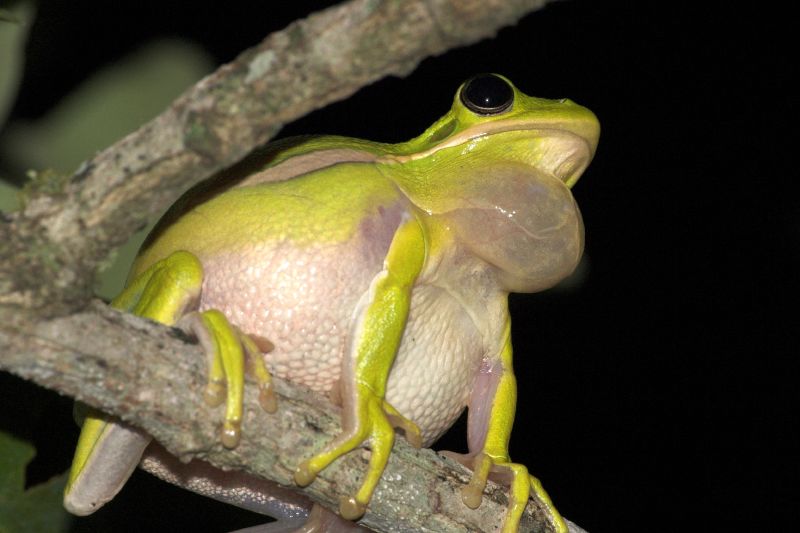|
| Query: green frog | Result: 25th of 289 | |
American Green Treefrog (Hyla cinerea) - Wiki
| Subject: | American Green Treefrog (Hyla cinerea) - Wiki
| |

| Resolution: 800x533
File Size: 57414 Bytes
Date: 2006:07:04 20:54:20
Camera: Canon EOS DIGITAL REBEL (Canon)
F number: f/20.0
Exposure: 1/200 sec
Focal Length: 190/1
Upload Date: 2007:08:14 14:47:12
|
American green tree frog
From Wikipedia, the free encyclopedia
[Photo] American Green Tree Frog (Hyla cinerea) with distended vocal sac. Date: July 04, 2006 at 20:54. Author Clinton & Charles Robertson http://www.flickr.com/people/20087733@N00 from Del Rio, Texas & College Station, TX, USA
The American green tree frog (Hyla cinerea) is a common species of New World tree frog belonging to the genus Hyla. It is a popular species of pet frog.
Habitat
The habitat of American green tree frogs is usually near lakes, farm ponds, floodplain sloughs, cattail marshes, or bald cypress swamps. They inhabit the southern United States and some areas to the north and west, including all of Florida, southern Georgia, Louisiana, Delaware, eastern Maryland and Virginia, eastern North and South Carolina, eastern Texas, and areas extending along the Mississippi Valley to southern Illinois. They may possibly inhabit northeastern Mexico.
This is a common backyard species that can often be seen at porch lights, where they may gather to look for insects to eat. During the day, the green tree frogs may be found resting on the plants beside the pond.
Characteristics
The frog is medium-sized, up to 6 cm (2.5 inches). Their bodies are usually colored green with shades ranging from bright yellowish olive to lime green. The darkness of the color can change depending on lighting or temperature. There may be some small patches of gold or white. They may also have a white, pale yellow, or cream-colored line running from the jaw or upper lip to the groin. They have smooth skin and large toe pads. The abdomen is pale yellow to white. Males have wrinkled throats (indicating the vocal pouch) and are slightly smaller than females. Like most frogs, they eat a diet of insects (mostly crickets, moths, and flies) and other small invertebrates.
The mating season takes place from mid-April to mid-August. Females lay up to 400 eggs in shallow water, which attach to the roots of aquatic plants. Embryos hatch within a week and tadpoles transform between 55 to 63 days after hatching. Weather conditions influence breeding, which often takes place in rain. Indeed, the frogs often seen during and after a rainstorm.
Tadpoles in captivity eat boiled vegetables, such as cucumbers or lettuce.
As pets and as state amphibian
The American green tree frog is available in most pet stores and cost between US$10-$20 each. They are relatively easy frogs to take care of. They need a large (at least ten-gallon) terrarium and do well with bark, pebbles, or even paper towels on the floor of their terrarium.
The American green tree frog is the state amphibian of Georgia and Louisiana.
http://en.wikipedia.org/wiki/American_green_tree_frog
| The text in this page is based on the copyrighted Wikipedia article shown in above URL. It is used under the GNU Free Documentation License. You may redistribute it, verbatim or modified, providing that you comply with the terms of the GFDL. |
|
Comments |
|---|
| | Guest |
|
Scientific Name: Hyla cinerea (Schneider, 1799)
Common Names: American Green Treefrog, Carolina Tree Frog, Green Treefrog
Synonyms:
Calamita cinereus Schneider, 1799
Calamita lateralis (Bosc, 1800)
Dryophytes cinereus (Schneider, 1799)
Hyla blochii Daudin, 1802
Hyla evittata Miller, 1899
Hyla holmani Lynch, 1966
Hyla semifasciata Hallowell, 1857
Rana bilineata Shaw, 1802
Rana lateralis (Bosc, 1800) |
^o^
Animal Pictures Archive for smart phones
^o^
|
|
|

